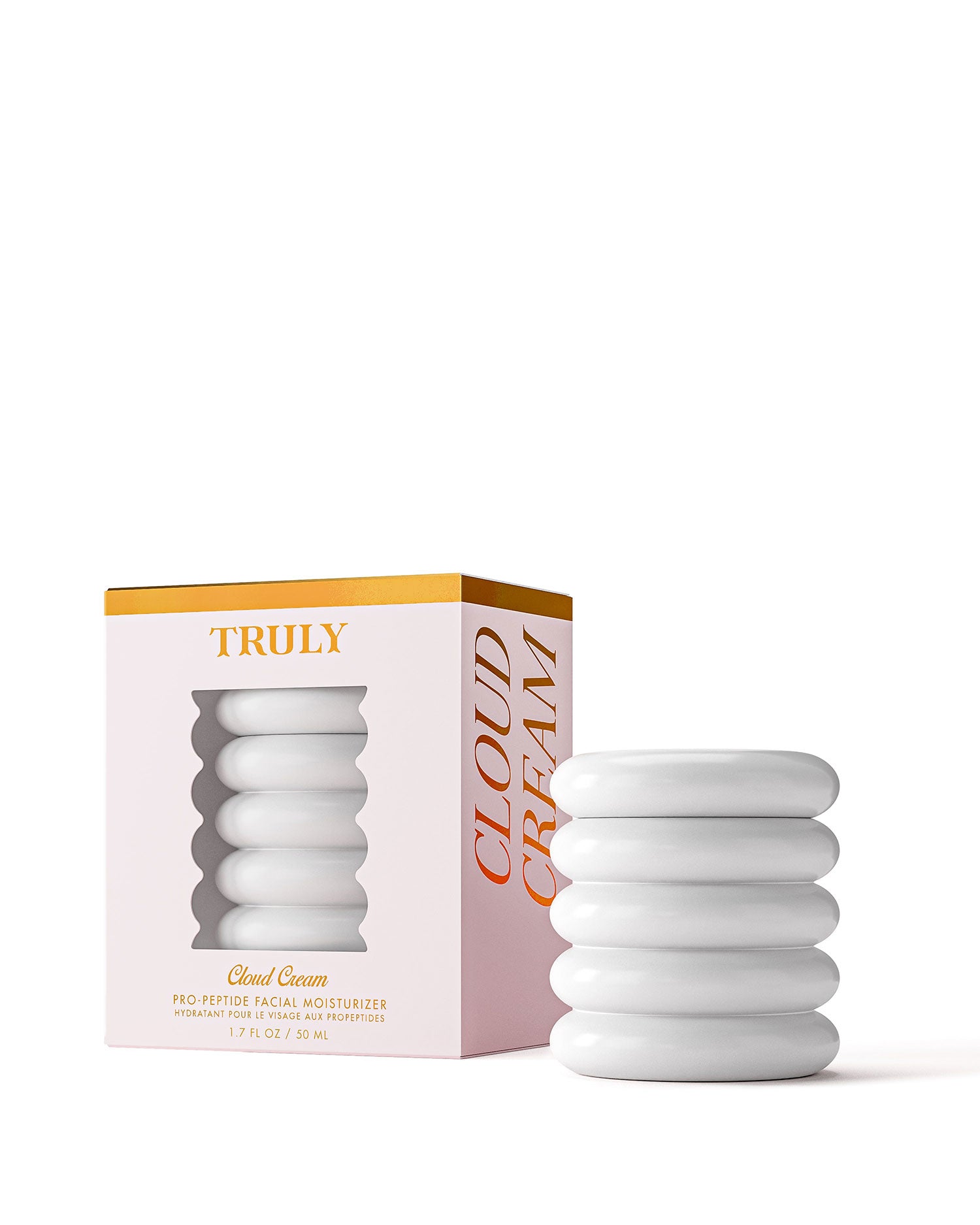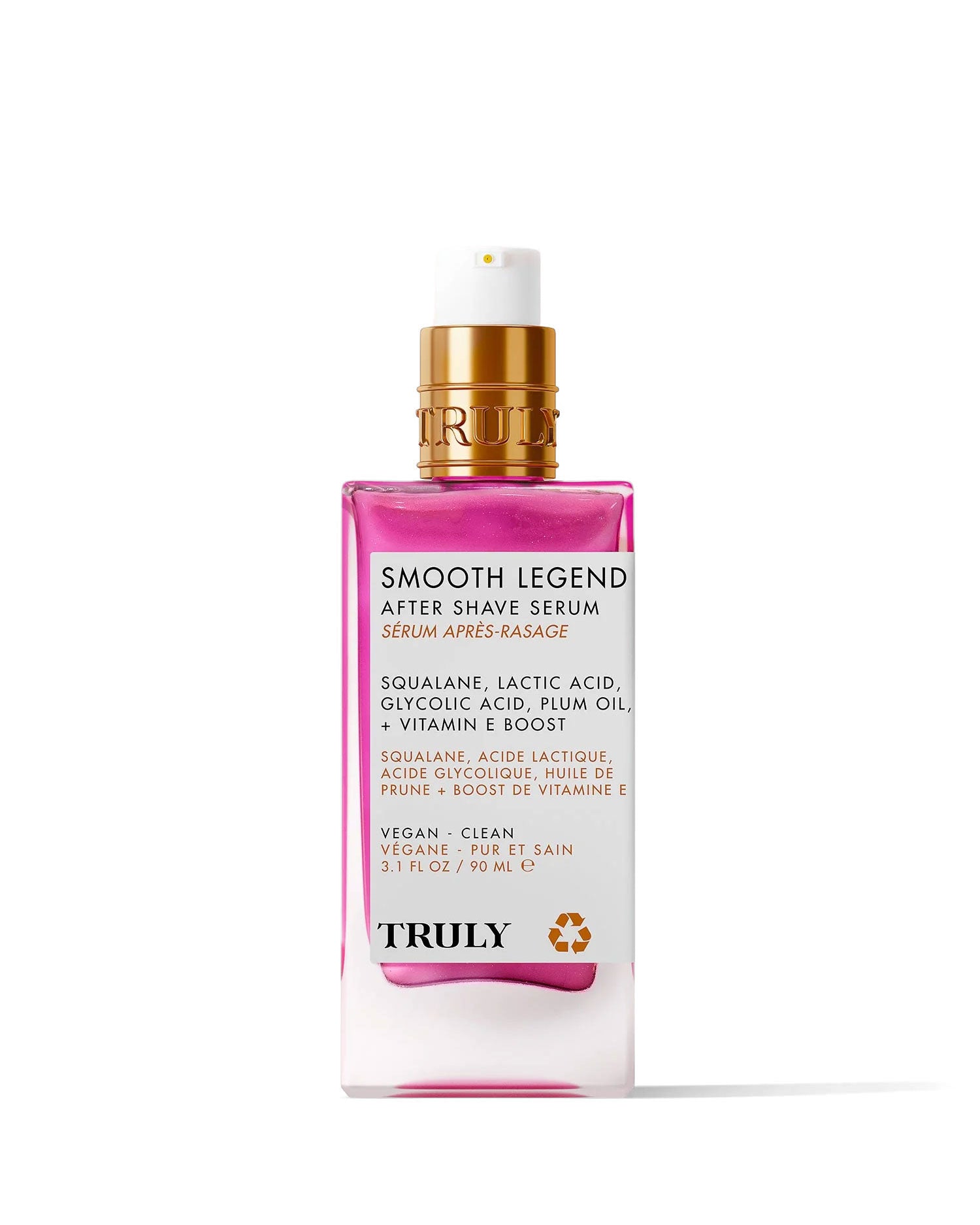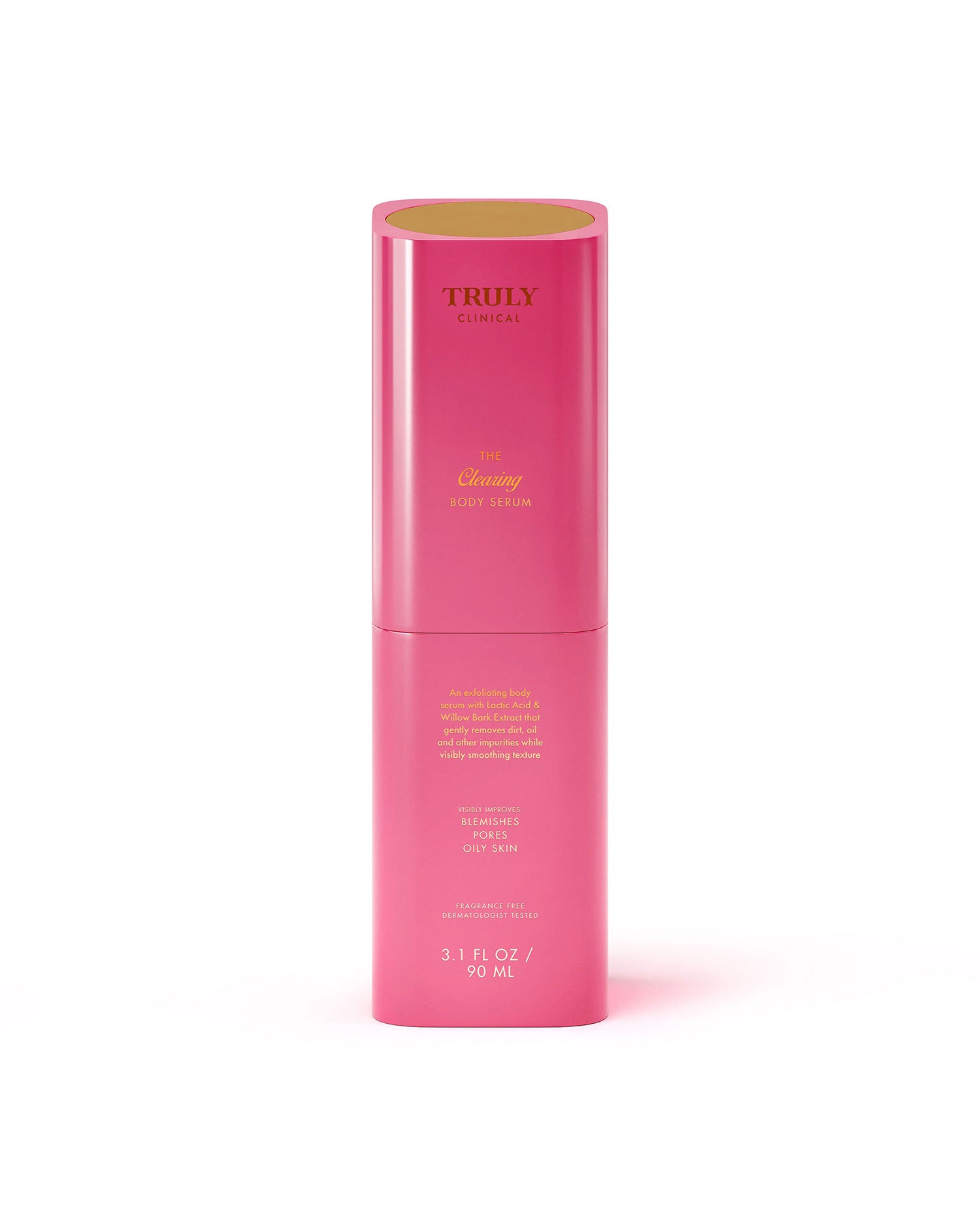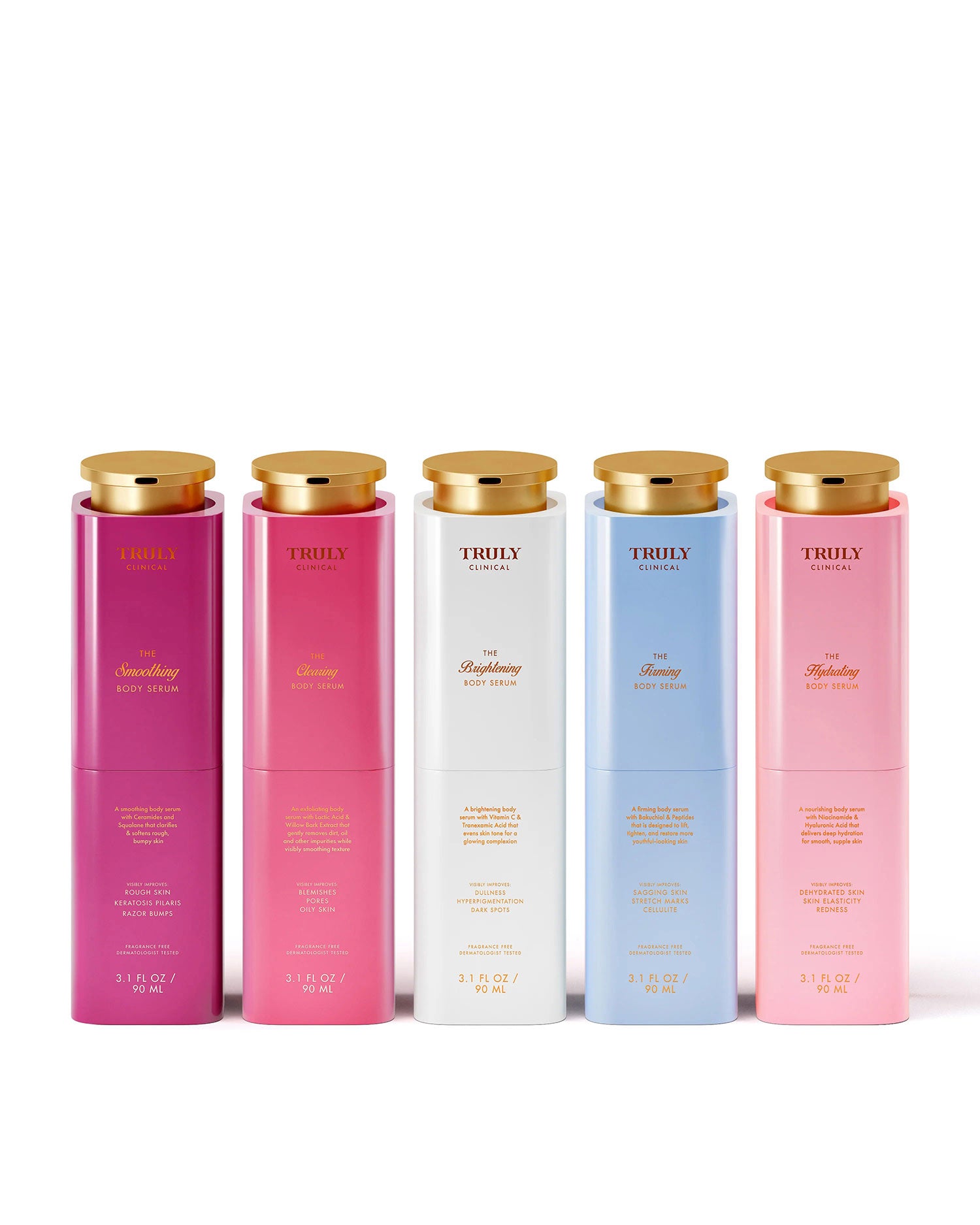Lactic Acid vs Glycolic Acid: What's the Difference?
November 09, 2025
By: Truly Beauty
Lactic acid vs glycolic acid — two excellent exfoliants, but only one is the perfect match for your skin type.
You're here because you want to know which is better, lactic acid or glycolic acid? Both are alpha hydroxy acids (AHAs) that exfoliate the skin, smooth texture, and improve skin tone, but they're still different.
Ahead, we'll show you the difference between lactic acid and glycolic acid and explain their full list of benefits. We'll also provide product recommendations that will best suit your skin type and specific needs.
Give Your Skin the Benefits of Both
At Truly Beauty, we've created a new gel moisturizer with an expertly crafted blend of lactic acid, glycolic acid, and hexapeptide-8 to visibly plump fine lines, soften textured skin, and leave skin with a beautiful youthful glow.
Key Ingredients: Lactic Acid, Glycolic Acid, Peptides | Lightweight & Fragrance-Free
If you want a moisturizer that does more than just hydrate, this is it. You'll notice softer, smoother, plumper skin from the first bottle.
Lactic Acid vs Glycolic Acid
Lactic acid and glycolic acid are both alpha hydroxy acids (AHAs), or chemical exfoliants, that remove dead skin cells by weakening the bonds that hold them together to reveal a brighter, smoother complexion. Let's take a closer look at lactic acid and glycolic acid.
What is Lactic Acid?
Lactic acid is a gentle exfoliating acid derived from milk (though most skincare formulas use vegan versions made through fermentation). It’s part of the AHA family, which works by dissolving dead skin cells on the surface to reveal fresher, brighter skin underneath.
What makes lactic acid unique is its larger molecular size. Because it doesn’t penetrate as deeply as glycolic acid, it’s much gentler and more hydrating, making it ideal for sensitive or dry skin types.
Benefits of Lactic Acid
Lactic acid doesn’t just smooth your skin. It hydrates while exfoliating, making it one of the most barrier-friendly acids out there that's gentle on sensitive skin.
Key Benefits:
- Gently exfoliates the skin for a smoother texture
- Hydrates thanks to its natural humectant properties
- Brightens dull complexions and fades dark spots over time
- Improves skin elasticity by stimulating collagen renewal
- Strengthens the skin barrier with consistent use
- Perfect for dry and sensitive skin
Shop Lactic acid and glycolic acid moisturizer
What is Glycolic Acid?
Glycolic acid is another alpha hydroxy acid (AHA) but it’s smaller in molecular size, meaning it penetrates deeper into the skin’s layers. It’s derived from sugar cane and is considered one of the most potent and fast-acting exfoliants in skincare.
Because it works below the surface, glycolic acid is great for fading dark spots, smoothing fine lines, and clearing clogged pores. However, it can be more intense, especially for beginners or those with sensitive skin.
Benefits of Glycolic Acid
When it comes to visible results, glycolic acid delivers fast. It penetrates the skin layers to clear pores, clarify blemishes, and smooth skin texture while brightening its appearance.
Key Benefits:
- Deeply exfoliates to improve skin tone and texture
- Reduces fine lines and wrinkles by boosting collagen
- Minimizes dark spots and hyperpigmentation
- Unclogs pores and helps prevent breakouts
- Improves radiance
- Perfect for oily skin and acne-prone skin
You Might Like
What’s the Difference Between Lactic Acid and Glycolic Acid?
While both lactic acid and glycolic acid are AHAs that exfoliate and brighten the skin, they differ in molecular size, strength, hydration, and irritation potential which affects how they work on your skin.
- Molecular Size & Penetration: Glycolic acid has a smaller molecule, allowing it to penetrate deeper into the skin for faster and more intense exfoliation. Lactic acid’s larger molecule works more gently on the surface, making it ideal for sensitive or dry skin.
- Hydration: Lactic acid doubles as a humectant, drawing moisture into the skin while it exfoliates. Glycolic acid is less hydrating and can sometimes leave skin feeling drier if not paired with a moisturizer.
- Irritation Potential: Because glycolic acid penetrates more deeply, it carries a higher risk of irritation, redness, or flaking, especially for beginners. Lactic acid is much gentler, causing minimal irritation in most users.
- Results: Glycolic acid delivers faster, more visible results, smoothing fine lines, fading dark spots, and unclogging pores. Lactic acid provides a more gradual, steady improvement, perfect for maintaining glow and hydration over time.
Bottom line: Lactic acid is gentle, hydrating, and barrier-friendly, while glycolic acid is potent, deep-penetrating, and fast-acting. Choosing the right AHA comes down to your skin type, concerns, and tolerance.
Shop Lactic Acid and Glycolic Acid Serum
Glycolic Acid Provides Deeper Exfoliation
Glycolic acid is a chemical exfoliant derived from sugar cane. It has a smaller molecular size than lactic acid, which allows it to penetrate deeper into the skin—in turn, providing deeper exfoliation. Glycolic acid removes the buildup of dead skin cells and oil by dissolving them to unclog pores, improve skin texture, and prevent breakouts.
It’s considered to be one of the best exfoliators for normal to oily skin, as well as acne-prone skin. By penetrating deeper into the pores, glycolic acid maximizes pore-unclogging action to keep skin smooth and clear.
And because glycolic acid can get deeper into your skin, it’s a fantastic anti-aging skincare ingredient.“Glycolic acid stimulates fibroblasts in the dermis to produce increased amounts of collagen,” says dermatologist Kenneth Howe, M.D.. By increasing collagen production, it makes skin feel firmer and helps reduce the appearance of fine lines.
Lactic Acid is Easier on Sensitive Skin
Lactic acid is another AHA derived from fermented lactose, a carbohydrate naturally present in milk. It’s a lot milder than glycolic acid. Because of its higher molecular weight, lactic acid doesn’t penetrate as deep and has a lower risk of skin irritation. For that reason, it’s the best choice for sensitive skin types.
Lactic acid is gentler than other AHA and BHA acids. It is a mild exfoliant which will not disrupt the skin’s pH or cause redness, dryness, flaking, and irritation. In fact, skincare products with low concentrations of lactic acids can even be used daily.
Glycolic Acid Works Faster
Going back to glycolic acid’s small molecular size, it means the AHA can penetrate deeply and quickly into the skin to deliver visible results—fast. In fact, glycolic acid’s effects on brightening your skin happen almost instantly.
This fast-acting ingredient is great for sloughing off dead cells to reveal instantly brighter, glowier skin. That said, those with normal, oily, or acne-prone skin are most likely to enjoy the benefits of glycolic acid over those with dry or sensitive skin.
Lactic Acid is More Hydrating
In addition to being an exfoliant, lactic acid is also a humectant, meaning it attracts water to hydrate the skin and combat dryness. With regards to lactic acid vs glycolic acid and which is better for your skin, lactic acid is the better choice for dry skin types.
There are two reasons for this. First, lactic acid has humectant properties which help to attract and seal moisture into the skin for long-lasting hydration. Second, its larger molecular size means it is less likely to irritate or dry out the skin. All in all, lactic acid might be the better option if you’re prone to dryness.
Is Lactic Acid or Glycolic Acid Better?
When it comes to lactic acid vs glycolic acid which is better, it all comes down to your skin type and what you’re hoping to achieve from this ingredient. If you have oily or acne-prone skin and you’re looking to target breakouts and clogged pores fast, glycolic acid is your best choice. If you have dry or sensitive skin and you’re looking for a gentle exfoliant that won’t irritate your skin, you’re better off with lactic acid.
In terms of what they can do for your skin, both AHAs remove dead cells and promote cell turnover for clearer, brighter, and smoother skin.
Can You Use Lactic Acid and Glycolic Acid Together?
Yes, you can use glycolic acid and lactic acid together. However, you should only use them together if both ingredients are present in the same skincare products, in which case there will be lower concentrations of these AHAs. When using these two AHAs in separate products at the same time, you expose your skin to higher concentrations of these ingredients which may cause irritation.
As the last step of your skincare routine, always remember to apply sunscreen with SPF 30 or higher. Besides protecting your skin against sun damage, AHAs can make your skin more sensitive to the sun, which can lead to sunburn and irritation.
How to Use Glycolic and Lactic Acid in Your Skincare Routine
Lactic acid and glycolic acid are both alpha hydroxy acids (AHAs) that can be incorporated into a skincare routine to exfoliate and improve skin texture. Here’s how to use them in your skincare routine.
Understand Your Skin Type: Lactic acid tends to be milder and better suited for sensitive or dry skin. Glycolic acid is more potent and is often recommended for normal to oily skin types.
Start Slowly: If you’re new to using acids, start with a lower concentration to allow your skin to adjust. Begin with products containing around 5-10% concentration. Start by using these acids once or twice a week and gradually increase the frequency as your skin builds tolerance.
Patch Test: Before applying any new product to your face, perform a patch test on a small area of your skin to ensure your skin doesn’t react negatively.
Lactic acid and glycolic acid pair well with most other skincare products, including hyaluronic acid, shea butter, coconut oil, and vitamin C. However, you should avoid mixing these AHAs with retinol or salicylic acid if you have sensitive skin.
FAQ: Lactic Acid vs Glycolic Acid
What Is the Difference Between Lactic Acid and Glycolic Acid?
Both are AHAs (Alpha Hydroxy Acids) that exfoliate and brighten the skin, but glycolic acid penetrates deeper for faster results, while lactic acid is gentler, more hydrating, and better for sensitive or dry skin.
Can I Use Lactic Acid and Glycolic Acid Together?
Yes, but use them carefully. Alternate nights or choose a product that combines both at safe concentrations. Always follow with SPF 30+ in the morning.
Which AHA Is Best for My Skin Type?
Lactic acid is ideal for sensitive, dry, or beginner skin. Glycolic acid works best for oily, acne-prone, or mature skin. Combination skin can benefit from alternating the two.
How Often Should I Use Lactic Acid or Glycolic Acid?
Start with 1–2 times per week to build tolerance. Lactic acid can often be used more frequently, while glycolic acid is best 2–3 times per week depending on concentration and skin sensitivity.
Can I Use AHAs During Pregnancy?
Lactic acid in low concentrations is generally considered safe during pregnancy. Glycolic acid is more potent, so consult your doctor before use.
Do I Need to Wear Sunscreen When Using Lactic Acid or Glycolic Acid?
Yes! AHAs make your skin more sensitive to UV damage. Always apply broad-spectrum SPF 30 or higher during the day.
Which is Better, Lactic Acid or Glycolic Acid?
From smoothing out fine lines to combating breakouts and giving skin a brightening boost, both of these alpha hydroxy acids can work wonders for your skin. Glycolic acid is the more potent of the two. Because of its smaller molecular size, it penetrates deeper into the skin to provide more visible, faster results. Lactic acid, on the other hand, has a larger molecular size which means it doesn’t penetrate as quickly and is less likely to irritate the skin.
With regards to the lactic acid vs glycolic acid debate, we love both ingredients. However, you should decide based on your skin type and concerns.
In this article
-
Lactic Acid vs Glycolic Acid: What's the Difference?
-
Lactic Acid vs Glycolic Acid
-
What’s the Difference Between Lactic Acid and Glycolic Acid?
-
Is Lactic Acid or Glycolic Acid Better?
-
Can You Use Lactic Acid and Glycolic Acid Together?
-
How to Use Glycolic and Lactic Acid in Your Skincare Routine
-
FAQ: Lactic Acid vs Glycolic Acid
-
What Is the Difference Between Lactic Acid and Glycolic Acid?
-
Can I Use Lactic Acid and Glycolic Acid Together?
-
Which AHA Is Best for My Skin Type?
-
How Often Should I Use Lactic Acid or Glycolic Acid?
-
Can I Use AHAs During Pregnancy?
-
Do I Need to Wear Sunscreen When Using Lactic Acid or Glycolic Acid?
-
What Is the Difference Between Lactic Acid and Glycolic Acid?
-
Which is Better, Lactic Acid or Glycolic Acid?



























